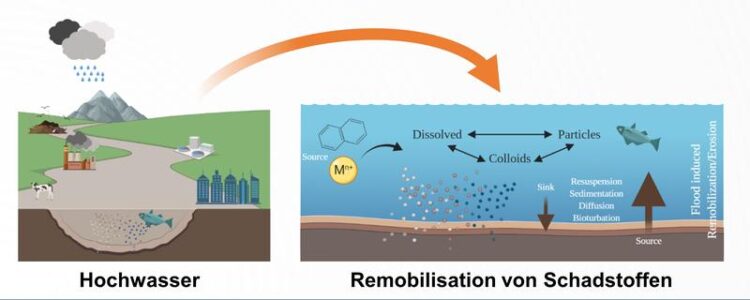Flood water: Toxins from the riverbed

The remobilisation of pollutants from sediments during severe flooding is a so far underestimated consequence of extreme events.
Crawford et al.(2021) J.Haz Mat / Goethe University Frankfurt
A long-term hazard from flood water is often underestimated: The raging rivers swirl up pollutants out of their sediments that stem from environmental pollution decades or centuries ago. Such harmful substances can not only cause ecological damage in the river. They can also deposit themselves on flooded areas and affect crops, grazing livestock and humans. This has been pointed out by an international research team in a review of scientific studies on flood events throughout the world. The paper has been published in the Journal of Hazardous Materials and was produced under the leadership of Goethe University.
Sediments are regarded as a river’s long-term memory. They mainly comprise particles that are eroded from the ground, ending up at some point in river deltas or the sea. However, sediments can also remain stable for a relatively long time – and bind pollutants which, for example, have entered the rivers through mining or industrial wastewater. As a consequence, many old river sediments contain pollutants as “chemical time bombs”, such as heavy metals or dioxins and dioxin-like compounds that are not easily degradable.
During flood events in the more industrial regions of Europe, North America and Asia, old sediments can be churned up as a result of the high speeds at which the water is flowing. In the process, the pollutants bound in them are regularly released in one go and contaminate flooded areas. An interdisciplinary team of researchers from Goethe University, RWTH Aachen University and the University of Saskatchewan in Canada, along with other partners, has compiled a review of previous scientific studies on this topic.
In it, the researchers, headed by junior research group leader Dr Sarah Crawford in Frankfurt and Canadian researcher Professor Markus Brinkmann, show, for example, which pollutant loads were measured after various flood events, which test systems were developed for different pollutants and how different sediments behave when water flows at high speeds. It describes the risks for drinking water production, the influence of temperature on pollutant intake by fish and methods for assessing the economic costs associated with the remobilisation of pollutants.
Despite the many years of research on this subject, Henner Hollert, professor of environmental toxicology at Goethe University and senior author of the publication in hand, is greatly concerned: “I have the impression that the problem of pollutants from old sediments is greatly underestimated in Germany and also in Europe as a whole. One reason for this could also be that to date there have been practically no studies at all on the economic consequences of this problem, as we’ve been able to show. However, contaminated sediments are a ticking time bomb that can explode each time there’s a flood. What we need now is good river management across the board that not only looks at immediate hazards for humans, animals and infrastructure but also at the long-term consequences resulting from pollutants in the riverbeds. It’s imperative, for example, that we examine flooded areas used agriculturally for river-specific pollutants so that these do not end up on our plates in the form of meat and dairy products.”
In an interdisciplinary approach, researchers from Goethe University Frankfurt, in collaboration with RWTH Aachen University, the University of Saskatchewan in Canada, the Helmholtz Centre for Environmental Research in Leipzig, the Institute for Social-Ecological Research (ISOE), the Senckenberg Institute, the LOEWE Centre for Translational Biodiversity Genomics and many other partners, are also studying the recent extreme flood events in Rhineland-Palatinate and North Rhine-Westphalia in terms of hydraulic engineering and the biological, ecotoxicological, ecological, geoscientific but also the social-ecological and economic consequences. These studies are embedded in the new research cluster RobustNature at Goethe University, which is examining the robustness and resilience of nature-society systems in the changing Anthropocene and aims to contribute to knowledge-based transformation research using the examples of biodiversity and water – that is, from knowledge to action.
Wissenschaftliche Ansprechpartner:
Professor Henner Hollert
Department of Evolutionary Ecology and Environmental Toxicology
Institute of Ecology, Diversity and Evolution
Goethe University
and
LOEWE Centre for Translational Biodiversity Genomics
Phone +49 69 798-42171 and +49-151-14042119
hollert@bio.uni-frankfurt.de
https://www.bio.uni-frankfurt.de/43970666/AK_Hollert
Originalpublikation:
Sarah E. Crawford, Markus Brinkmann, Jacob D. Ouellet, Frank Lehmkuhl, Klaus Reicherter, Jan Schwarzbauer, Piero Bellanova, Peter Letmathe, Lars M. Blank, Roland Weber, Werner Brack, Joost T. van Dongen, Lucas Menzel, Markus Hecker, Holger Schüttrumpf & Henner Hollert: Remobilization of pollutants during extreme flood events poses severe risks to human and environmental health. Journal of Hazardous Materials 421 (2022) 126691 https://doi.org/10.1016/j.jhazmat.2021.126691
Media Contact
All latest news from the category: Ecology, The Environment and Conservation
This complex theme deals primarily with interactions between organisms and the environmental factors that impact them, but to a greater extent between individual inanimate environmental factors.
innovations-report offers informative reports and articles on topics such as climate protection, landscape conservation, ecological systems, wildlife and nature parks and ecosystem efficiency and balance.
Newest articles

Innovative 3D printed scaffolds offer new hope for bone healing
Researchers at the Institute for Bioengineering of Catalonia have developed novel 3D printed PLA-CaP scaffolds that promote blood vessel formation, ensuring better healing and regeneration of bone tissue. Bone is…

The surprising role of gut infection in Alzheimer’s disease
ASU- and Banner Alzheimer’s Institute-led study implicates link between a common virus and the disease, which travels from the gut to the brain and may be a target for antiviral…

Molecular gardening: New enzymes discovered for protein modification pruning
How deubiquitinases USP53 and USP54 cleave long polyubiquitin chains and how the former is linked to liver disease in children. Deubiquitinases (DUBs) are enzymes used by cells to trim protein…



